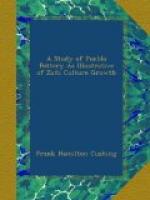In these regions water not only occurs in small quantities, but is obtainable only at points separated by great distances, hence to the Pueblos the first necessity of life is the transportation and preservation of water. The skins and paunches of animals could be used in the effort to meet this want with but small success, as the heat and aridity of the atmosphere would in a short time render water thus kept unfit for use, and the membranes once empty would be liable to destruction by drying. So far as language indicates the character of the earliest water vessels which to any extent met the requirements of the Zuni ancestry, they were tubes of wood or sections of canes. The latter, in ritualistic recitation, are said to have been the receptacles that the creation-priests filled with the sacred water from the ocean of the cave-wombs of earth, whence men and creatures were born, and the name for one of these cane water vessels is sho tom me, from sho e, cane or canes, and tom me, a wooden tube. Yet, although in the extreme western borders of the deserts, which were probably the first penetrated by the Pueblos, the cane grows to great size and in abundance along the two rivers of that country, its use, if ever extensive, must have speedily given way to the use of gourds, which grew luxuriantly at these places and were of better shapes and of larger capacity. The name of the gourd as a vessel is shop tom me, from sho e, canes, po pon nai e, bladder-shaped, and tom me, a wooden tube; a seeming derivation (with the exception of the interpolated sound significant of form) from sho tom me. The gourd itself is called mo thla a, “hard fruit.” The inference is that when used as a vessel, and called shopi tom me, it must have been named after an older form of vessel, instead of after the plant or fruit which produced it.
While the gourd was large and convenient in form, it was difficult of transportation owing to its fragility. To overcome this it was encased in a coarse sort of wicker-work, composed of fibrous yucca leaves or of flexible splints. Of this we have evidence in a series of gourd-vessels among the Zunis, into which the sacred water is said to have been transferred from the tubes, and a pair of which one of the priests, who came east with me two years ago, brought from New Mexico to Boston in his hands—so precious were they considered as relics—for the purpose of replenishing them with water from the Atlantic. These vessels are encased rudely but strongly in a meshing of splints (see Fig. 500), and while I do not positively claim that they have been piously preserved since the time of the universal use of gourds as water-vessels by the ancestry of this people, they are nevertheless of considerable antiquity. Their origin is attributed to the priest-gods, and they show that it must have once been a common practice to encase gourds, as above described, in osiery.




